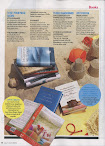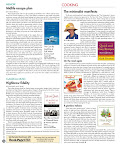| French police guarded the ministry from angry fishermen |
French fishermen have clashed with police in Paris as they stepped up protests over rising fuel costs.
Protesters threw flares and police fired tear gas outside the agriculture ministry, where Minister Michel Barnier was meeting fishing unions.
Ferry traffic with the UK has also ground to a halt, with fishing fleets blockading several French ports.
Meanwhile, a major strike against President Nicolas Sarkozy's pension reforms is set to begin.
Workers are due to walk out for 36 hours, starting on Wednesday evening, to protest against government plans to make people work 41 years, rather then the current 40, before being able to draw a full pension.
Price cap
The fishermen's blockade began more than a week ago, and was originally confined to a few ports like La Rochelle on the west coast.
But it spread until, on Wednesday, Calais, Boulogne and Dunkirk on the north coast, all serving cross-Channel ferry services to Britain, were isolated by a ring of fishing boats.
The fishermen say rapidly rising prices for diesel threaten them with bankruptcy. They are demanding a greater subsidy from the government, in effect putting a cap on prices.
In January the government approved an aid package for fishermen worth 310m euros (£248m) over three years.
Mr Barnier is seeking approval from the EU commission to give state aid to the sector.
But fishermen say that agreement is redundant, since fuel has become 30% more expensive since the start of the year.
As the minister met union representatives in Paris on Wednesday, as many as 200 fishermen gathered outside.
Dozens of flares were thrown, injuring up to four policemen, according to reports.
Riot police surrounded the building and responded with tear gas.
Sarkozy confident
The fishermen's protest came as the government is facing industrial action from various sectors.
| French teachers say cuts in numbers affect quality |
Port workers plan a strike for Thursday against privatisation - which is likely to exacerbate the problems caused by the fishing blockade.
Thursday will also see major action by rail, postal, utility and other public sector workers across France.
They are protesting against plans to extend the retirement age.
It follows a teachers' strike against job cuts last week.
Unions are hoping that a head of steam is building up against Mr Sarkozy's economic reform plans, says BBC correspondent Hugh Schofield in Paris.
But the president has so far made the calculation that most people accept the changes that he has promised, and there is no sign of him backing down, says our correspondent.
--From the BBC











